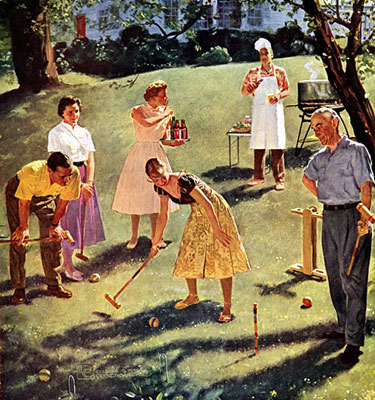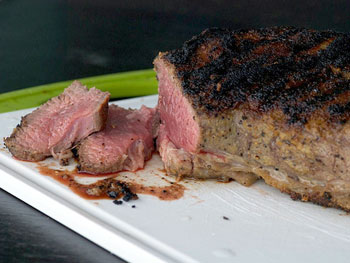 Barbecue. You know what it means, right? Are you sure? Having grown up in Rhode Island I always thought a "barbecue" referred to an outdoor cookout featuring grilled hot dogs and hamburgers. It wasn't until we moved to North Carolina that we discovered "barbecue" had nothing to do with hot dogs and hamburgers and everything to do with slowly cooking a whole hog over some flames.
Barbecue. You know what it means, right? Are you sure? Having grown up in Rhode Island I always thought a "barbecue" referred to an outdoor cookout featuring grilled hot dogs and hamburgers. It wasn't until we moved to North Carolina that we discovered "barbecue" had nothing to do with hot dogs and hamburgers and everything to do with slowly cooking a whole hog over some flames.
Now that we live in Southern California, I've fallen for Santa Maria-style barbecue made from tri-tip, a flavorful, triangular cut of beef from the bottom sirloin.
Santa Maria-style barbecue originated in the Santa Maria Valley in Central California in the 19th century. After cattle round-ups, American cowboys, known as vaqueros, would host huge gatherings that featured beef skewered and cooked over a red oak fire. The beef was simply seasoned with salt and pepper and served with Pinquito beans, salsa, bread, and simple desserts. It hasn't changed much in almost two centuries.
Retro Recipes and Traditional Fare
Retro Recipes and Traditional Fare
Homemade Matzoh Ball Soup
 The change in temperature; going from cold to hot to cold again has wreaked havoc on my family and their health. Me included. Last week, there were two mornings that I dropped the kids off at school, came home, and got right back into bed. Slept for hours, with a puppy on my belly. Regardless of feeling totally crappy, there truly is nothing better than getting back under the covers (at 9:00 a.m.) with a cozy, little Lola close by.
The change in temperature; going from cold to hot to cold again has wreaked havoc on my family and their health. Me included. Last week, there were two mornings that I dropped the kids off at school, came home, and got right back into bed. Slept for hours, with a puppy on my belly. Regardless of feeling totally crappy, there truly is nothing better than getting back under the covers (at 9:00 a.m.) with a cozy, little Lola close by.
Thank goodness for my freezer. Meal planning, prepping, and stocking the freezer pays off. In my opinion, it’s a wonderful feeling, opening the freezer door and seeing laborious hours spent in the kitchen, put to good use.
Before crawling back into bed, I went to my extra freezer and took out three quarts of chicken stock. I also grabbed 2 organic chicken breasts and set both on a rimmed baking sheet to thaw. After several hours of napping, I had just enough energy to roast the chicken, cut the veggies, and prep the matzoh balls.
For my family, matzo ball soup is one of our favorite comfort meals. It’s a one pot meal that covers all the food groups; protein, grains, vegetables, and fat. Plus, this meal leaves plenty of room for dessert.
Roots of New Year’s Food Traditons
“Eat poor that day, eat rich the rest of the year… Rice for riches and peas for peace.” – Old Southern saying for New Year’s Menu
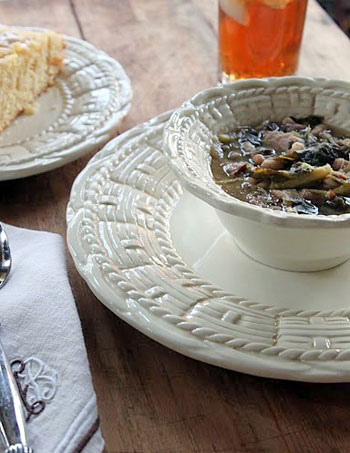
Collard greens, black eyed peas, cornbread and pork are the foodstuffs of the South, rich in legend, lore, and superstition. Money or not, every Southern family I know dines on these same vittles for their New Year’s supper. Not too poor of eating if I say so myself.
According to this Farmer, the New Year’s Day menu is a Southern supper at its finest. Steeped in tradition, flavored with history, and doused with a touch of superstition, this meal encompasses the South’s ebb and flow of classicism and eccentricity–a meal of our heritage. Here in America’s Deep South, the cultures of Europe, Africa and the Native Americans combine with their respected refinements and sentimentalities making this meal fit to usher in a new year.
Growing up in rural Middle Georgia, we knew our food’s legacy before it arrived on our tables. This Farm to Table movement of late has always been the custom for those of us raised in a more bucolic fashion. We know our farmers and growers. In his blessings before a meal, my brother-in-law’s father always gives thanks for “not only the hands that prepared the food but grew it as well...” whereas our New Year’s meal is of no exception.
How to Make Mostarda
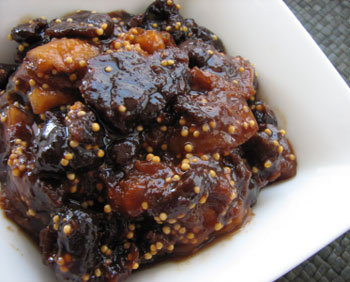 I spent a year living in Europe, and six months of that was in Italy. Having eaten a lot of Italian food, I like to think I understand it, perhaps just a little. In fact, whenever I try to recreate an Italian dish I think back to earlier versions that I've eaten. What was it that I liked about it? What was the essence of the dish?
I spent a year living in Europe, and six months of that was in Italy. Having eaten a lot of Italian food, I like to think I understand it, perhaps just a little. In fact, whenever I try to recreate an Italian dish I think back to earlier versions that I've eaten. What was it that I liked about it? What was the essence of the dish?
In all my time in Italy, I don't remember trying mostarda. It's not surprising really because the most well-known versions come from Veneto, Lombardia and Piemonte. Most of my time was spent in Tuscany. But I still think I understand mostarda, just a bit. It's like an Italian chutney I suppose. Don't make the mistake of translating it as "mustard". Mostarda does have a little bit of mustard in it, but it's really a combination of preserved fruit in syrup with a bit of a kick. The kick comes from mustard oil, mustard essence, dry mustard, mustard seeds or some combination thereof. Other ingredients include sugar or honey, wine, vinegar and sometimes citrus juice.
When I am developing a recipe, I often look for several variations then strike off on my own. The recipes I found for mostarda varied greatly--some used dry fruit, others fresh fruit. Some cooked slowly others cooked quickly. Some had lots of mustard, others barely a pinch. My own experiment lead me to this conclusion: Mostarda is very forgiving and can easily be made to your own taste. You can taste as you go and make changes.
Cioppino with Roasted Tomatoes
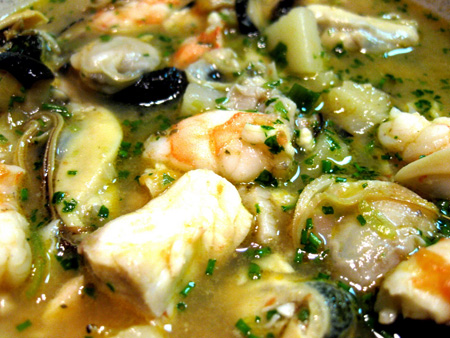 Cioppino is said to have originated among fishermen who made their dinners out of the fish and shellfish they couldn't sell in the morning. Although it has evolved into a pricey item on upscale menus, at heart cioppino is comfort food.
Cioppino is said to have originated among fishermen who made their dinners out of the fish and shellfish they couldn't sell in the morning. Although it has evolved into a pricey item on upscale menus, at heart cioppino is comfort food.
Traditionally cioppino features fresh crab, reflecting the origin of the dish in San Francisco where Dungeness crabs are plentiful. When crab isn't available or affordable, shrimp works just as well. Clams and mussels are essential to the dish, as are cubes of fish fillets. Flounder sole, tilapia, salmon, or halibut all work well.
Find a reliable supplier of seafood. To ensure we're getting the freshest ingredients, we buy our clams and mussels from Carlsbad Aqua Farm at the Santa Monica Farmers' Market (Wednesday and Sunday) and our flounder sole from Tropical Seafood at the Pacific Palisades Farmers' Market (Sunday).
More Articles ...
Welcome to the new One for the Table ...
Our Home Page will be different each time you arrive.
We're sure you'll find something to pique your interest...

